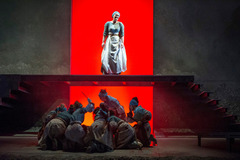| Opera Reviews | 29 April 2024 |
A psychological take on Iphigénie en Tauride
|
|
| Gluck: Iphigénie en Tauride English Touring Opera April 2016 |
|
|
This English Touring Opera production is pared down to the essentials of its psychological drama; the desolation of exile, the Scythians’ faith in blood-sacrifice, the Greek captives’ buddy-love. This simplicity continues in Anna Fleischle’s designs. The set has steps to a raised platform and a side door at the back, a ramp to under the platform and a tall vertical rectangle of light, at the top of which hangs an arrow-like symbol. For their sacrificial duties, the priestesses have a white sheet of apron belted over their dull blue-grey garments. The opera starts with a storm and flashes of lightning during which priestesses at Diana’s temple in Tauris bring on and butcher an invisible human sacrifice. It is a task which has to be carried out. The exhilaration is left to the Scythians, led by their king Thoas, sung with tremendous bluster by Craig Smith. They have brought newly-arrived captives for sacrifice, to one of which Iphigénie feels strangely drawn. Ania Jeruc, covering for an indisposed Catherine Carby as Iphigénie, is wearied by her exile and hungry for news of her family. The captives are emoting all over the place. John-Colyn Gueantey, as Pylades, may have known Orestes (Grant Doyle) since childhood, but doesn’t quite understand his friend’s death-wish. Orestes’ nightmare is dramatically lit, with hands reaching out from below the platform and Doyle’s singing evokes both torment and resignation to his fate. When Iphigénie visits, seeking news of her family, he tells (nearly) all. Her father is murdered by her mother, murdered in turn by her brother Orestes, news which casts her and her co-exiled priestesses into deeper despair. The chorus produces a powerful crescendo of grief when she informs them they have no more king and she no more kindred. They mourn her brother by miming his funeral rites using the white sheet of a shroud shaped as if it were the body. It is a touching and balletic enactment, choreographed by Bernadette Iglich. Iphigénie’s choice to save Orestes leads to an aria deliciously sung by Gueantey, but her plans are overturned when Orestes threatens to kill himself on the spot. Jeruc’s singing well conveys the psychological torture of having to kill the captive herself. She is spared that when Orestes (at last!) cries out her name, thus identifying himself. The orchestra, under conductor Martin André, plays with a lightness which balances the restraint on stage, particularly in the parts where it is dueting, rather than accompanying, the voices. The women’s chorus is in superb voice, their despair the greater for its understatement. This restraint heightens the contrast with Doyle’s highly emotional distress. Before the Scythians can take over the slaughter, Diane (Emma Caroe) arrives to set all to rights, and, for the first time, lighting designer Guy Hoare allows bright daylight to flood the stage.
|
|
| Text ©
Catriona Graham Photo © Richard Hubert Smith |

 The temptation is always there to update an opera and make it ‘relevant’ to today’s circumstances, but James Conway has eschewed that approach for Gluck’s Iphigénie en Tauride.
The temptation is always there to update an opera and make it ‘relevant’ to today’s circumstances, but James Conway has eschewed that approach for Gluck’s Iphigénie en Tauride.






